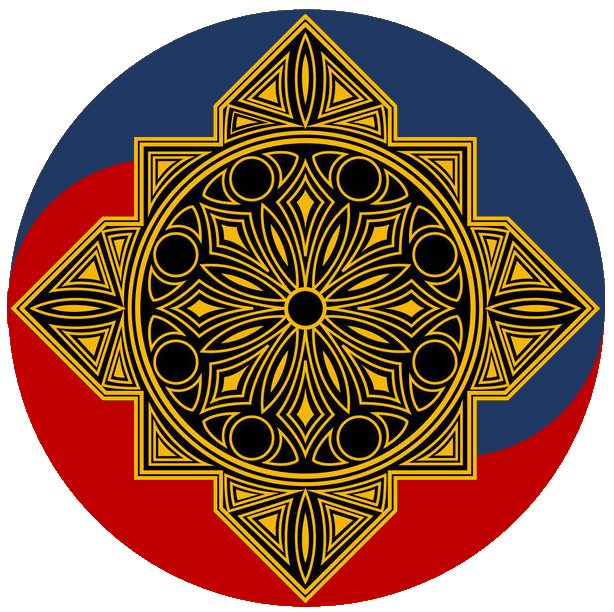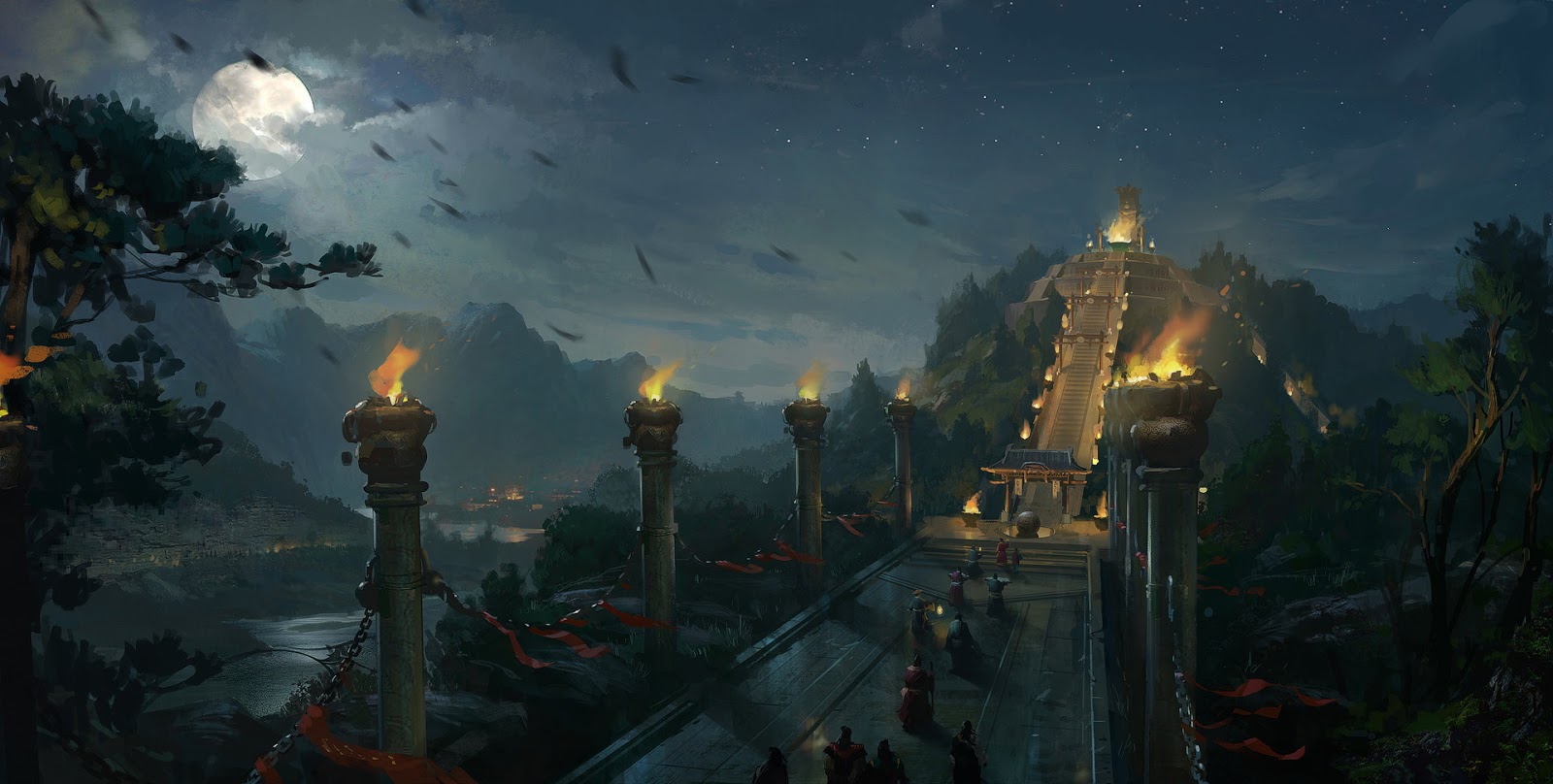Temple of Gortor
The Temple of Gortor, officially being called ''Dà Dìmiào'', or The Temple of the Greater Emperor, is the primary and state religion of the The Empire of Prabai since it was first formed at the start of the Second Age of the Man. It is a mix between southern shamanism and northern animism, combined with a strong centralised part largely revolving around the Emperor of Prabai, who is an important, even essential part of the henotheist religion.
The One Duality
Shuāngchóng Xìng, or The One Duality is the supreme duality mortals should know off, and is the highest form of existence that may impact the life of mortals. The One Duality directly references the duality of Gortor (commonly called Shàngdì, meaning God, instead of his actual name) and The Emperor, binding them together in divine law. The One Duality binds the divine to the mortal, and therefore Heaven and Earth. It is upon this basis that all other divinity stands.The Eight Powers
Bāguó , or the Eight Powers, it’s full name being Tiāntáng De Bā Zhǒng Lìliàng, or the Eight Powers of the Divine Sphere (Heaven), are the subdivision of the eight primordial powers who take and/or give power to/from Heaven to/from Earth. These are not to be confused with the Chénshì De Yuánshǐ Yuánsù (Primordial Elements of the Earthly), who are not in the Shén Lún (Wheel of Divinity) and belong to the Dìshàng Lìliàng (Earthly Powers). In essence these 8 always off weight each other, in order to preserve universal balance.The Eight Powers are:
- The Sun
- Creation of Life
- Spirits of Emotion
- Guiding of the Wind
- Guiding of the Sea
- Spirits of Comotion
- Transcendance to Heaven
- The Moon
The Earthly Powers
Dìshàng Lìliàng, or the earthly powers are the five primordial elements that all material energy is based on. It is a fivefold conceptual scheme that many traditional Prabaiian fields use to explain a wide array of phenomena, from cosmic cycles to the interaction between internal organs, and from the succession of political regimes to the properties of medicinal drugs. The "Five Phases" are Fire (huǒ), Water (shuǐ), Wood (mù), Metal (jīn), and Earth (tǔ).The Fases
The five phases are 60 days each and are usually used to describe the state in nature:- Wood/Spring: a period of growth, which generates abundant wood and vitality.
- Fire/Summer: a period of swelling, flowering, brimming with fire and energy.
- Earth: the in-between transitional seasonal periods, or a separate 'season' known as Late Summer or Long .
- Summer – in the latter case associated with leveling and dampening (moderation) and fruition.
- Metal/Autumn: a period of harvesting and collecting.
- Water/Winter: a period of retreat, where stillness and storage pervades.
Cycles
The doctrine of five phases describes two cycles, a generating or creation cycle, also known as "mother-son", and an overcoming or destruction cycle, also known as "grandfather-grandson", of interactions between the phases. Within Prabaiian traditional medicine the effects of these two main relations are further elaborated:- Inter-promoting (xiāngshēng): the effect in the generating (shēng) cycle
- Weakening (xiāngxiè): the effect in a deficient or reverse generating (shēng) cycle
- Inter-regulating (xiāngkè): the effect in the overcoming (kè) cycle
- Overacting (xiāngchéng): the effect in an excessive overcoming (kè) cycle
- Counteracting (xiāngwǔ): the effect in a deficient or reverse overcoming (kè) cycle
Show spoiler
Inter-promoting
Common verbs for the shēng cycle include "generate", "create" or "strengthens", as well as "grow" or "promote". The phase interactions in the shēng cycle are:- Wood feeds Fire
- Fire produces Earth (ash, lava)
- Earth bears Metal (geological processes produces minerals)
- Metal collects Water (water vapor condenses on metal)
- Water nourishes Wood
Weakening
A deficient shēng cycle is called the xiè cycle and is the reverse of the shēng cycle. Common verbs for the xiè include "weaken", "drain", "diminish" or "exhaust". The phase interactions in the xiè cycle are:- Wood depletes Water
- Water rusts Metal
- Metal impoverishes Earth
- Earth smothers Fire
- Fire burns Wood
Inter-regulating
Common verbs for the kè cycle include "controls", "restrains" and "fathers", as well as "overcome" or "regulate". The phase interactions in the kè cycle are:- Wood parts (or stabilizes) Earth (roots of trees can prevent soil erosion)
- Earth contains (or directs) Water (dams or river banks)
- Water dampens (or regulates) Fire
- Fire melts (or refines or shapes) Metal
- Metal chops (or carves) Wood
Overacting
An excessive kè cycle is called the chéng cycle. Common verbs for the chéng cycle include "restrict", "overwhelm", "dominate" or "destroy". The phase interactions in the chéng cycle are:- Wood depletes Earth (depletion of nutrients in soil, overfarming, overcultivation)
- Earth obstructs Water (over-damming)
- Water extinguishes Fire
- Fire vaporizes Metal
- Metal overharvests Wood (deforestation)
Counteracting
A deficient kè cycle is called the wǔ cycle and is the reverse of the kè cycle. Common verbs for the wǔ cycle can include "insult" or "harm". The phase interactions in the wǔ cycle are:- Wood dulls Metal
- Metal de-energizes Fire (metals conduct heat away)
- Fire evaporates Water
- Water muddies (or destabilizes) Earth
- Earth rots Wood (overpiling soil on wood can rot the wood)
Tian, its Li and Qi
Tian is both the physical heavens, the home of the sun, moon, and stars, and also the home of Gortor and ancestors. Tian by extension is source of moral meaning, as seen in the political principal, Mandate of Heaven, which holds that Tian, responding to human virtue, grants the imperial family the right to rule and can withdraw it when the dynasty should decline in virtue. This creativity or virtue in humans is the potentiality to transcend the given conditions and act wisely and morally. Tian is therefore both transcendent and immanent. Tian is defined in many ways, with many names, the most widely known being Tàidì (the "Great Deity") and Shàngdì (the "Primordial Deity"). A popular representation is the Yùdì (Jade Deity)or Yùhuáng (Jade Emperor). According to Gortorian theology he manifests in five primary forms (Wǔfāng Shàngdì, "Five Forms of the Highest Deity"). The qi is the breath or substance of which all things are made, including inanimate matter, the living beings, thought and gods. It is the continuum energy—matter.Bao and Ban, Gui and Shen
Bao and Ban , whose root meanings respectively are "shady" and "sunny", or "dark" and "light", are modes of manifestation of the qi, not material things in themselves. Bao is the qi in its dense, dark, sinking, wet, condensing mode; ban denotes the light, and the bright, rising, dry, expanding modality. Described as Taibao , they represent the polarity and complementarity that enlivens the cosmos. They can also be conceived as "disorder" and "order", "activity" or "passivity", with act (Ban) usually preferred over receptiveness (Bao). The concept "shén" is translated as "gods" or "spirits". There are shén of nature; gods who were once people, such as the fisherman Xu Xian; household gods, such as the Stove God; as well as ancestral gods (zu or zuxian). In the domain of humanity the shen is the "psyche", or the power or agency within humans. They are intimately involved in the life of this world. As spirits of stars, mountains and streams, shen exert a direct influence on things, making phenomena appear and things grow or extend themselves. Gortorian theology explains that they "are the spirits of Heaven" and they "draw out the ten thousand things". As forces of growth the gods are regarded as Ban, opposed to a Bao class of entities called "guǐ" (return, contraction), chaotic beings. A disciple of Zhu Xi noted that "between Heaven and Earth there is no thing that does not consist of Bao and Ban, and there is no place where Bao and Ban are not found. Therefore there is no place where gods and spirits do not exist".Centralisation
The Temple of Gortor is an order regulated ecclesiastical society, meaning that while the Temple is centralised around a strict hierarchy and every priest has its place in that, that there is no ''one-mother-church''. Instead, there are many state subsidised orders, following the same base ideals, but laying different priorities on the many parts of it. The Gortorian Orders, or ''Shàngdì de Shuāng Shèngzhǐ'', translated ''The Imperial Orders of the Duality of God'' are:- Tuìshǎi Zhāngjié De Shùnxù The Order of the Faded Chapter
- Huálì Dá'àn De Shùnxù The Order of the Ornate Answer
- Mángrén Kè Lǐsī xiéhuì The Society of the Blind Kris
- Cāngbái Tǎ Liánhé Huì The Union of the Pale Tower
- Wúxiàn Māotóuyīng Huì The Society of the Infinite Own
- Wúmíng Jué Xuéhuì The Society of the Unknown Horn

The Seal of Gortor, also called the Divine Wheel.
Type
Religious, Organised Religion



Comments